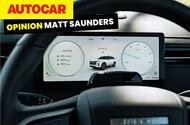The Jaecoo 7: A Cautionary Tale of Software Woes in Modern Vehicles
In the ever-evolving landscape of automotive technology, the term “software-defined vehicles” (SDVs) has been making waves. These vehicles promise a future where performance and functionality are primarily dictated by software rather than mechanical components. While the idea is thrilling—imagine cars that can be updated and improved over time—there’s a growing concern among consumers about the reliability of this software. After all, who hasn’t experienced a glitch during an over-the-air update?
Enter the Jaecoo 7, a mid-sized SUV from China that has recently hit the UK market. Produced by Chery, the country’s fourth-largest manufacturer, the Jaecoo 7 attempts to blend style and functionality, resembling a compact Range Rover Velar. However, beneath its sleek exterior lies a software experience that leaves much to be desired.
What’s Wrong with the Software?
At first glance, the Jaecoo 7 seems to check all the right boxes. It offers both petrol and plug-in hybrid versions, with the latter providing a surprisingly smooth and efficient ride. But the moment you delve into its software, the excitement quickly fizzles out. The car’s digital systems are riddled with inaccuracies that undermine the entire driving experience.
Take the trip computer, for instance. Instead of a conventional setup, the Jaecoo 7 tracks rolling 50km efficiency indicators for both hybrid and electric modes. The problem? These readings are wildly inaccurate. The hybrid mode stubbornly sticks at 60 mpg, while the electric mode often reports absurd figures, like over 1000 mpkWh. It’s hard to trust a system that feels more like a bad joke than a reliable tool.
Battery Monitoring: A Comedy of Errors
Then there’s the battery meter, which seems to have a mind of its own. It rarely dips below 20%, only to switch the car into hybrid mode when it’s deemed empty. Why tease drivers with a supposed eight miles of electric range when they can only access it under the dubious “EV+ driving mode,” which comes with a warning that it should only be activated in emergencies? It’s like saying, “You’re out of juice, but hey, here’s a surprise bonus—if you’re lucky enough to find it!”
Driver Assistance Systems: A Frustrating Experience
The issues don’t stop there. The calibration of the driver assistance systems is so intrusive that it can drive even the most patient driver to distraction. And when you connect your phone to Apple CarPlay, the ventilation controls and primary navigation bar mysteriously vanish, leaving you fumbling around the touchscreen. Speaking of the touchscreen, it resembles a budget tablet awkwardly attached to the dashboard, making it just as distracting to use as it is to look at.
Even the odometer, a seemingly straightforward piece of software, is flawed. It only counts miles driven in hybrid mode, conveniently ignoring electric miles. This raises questions about transparency, especially when it comes to resale time. After all, who wants to admit that their car has fewer miles on the clock when it’s been running on electric power?
The Bigger Picture: Software’s Role in Automotive Design
The Jaecoo 7 serves as a cautionary tale about the potential pitfalls of relying heavily on software in vehicles. While the automotive industry is excited about the possibilities of SDVs, the reality is that many manufacturers are still struggling to get the basics right. If a vehicle can’t accurately report its efficiency, battery status, or even its mileage, how can consumers trust it to perform reliably on the road?
As we move toward a future where cars are increasingly defined by their software, it’s essential for manufacturers to prioritize not just innovation but also reliability and user experience. The excitement of software updates and digital features should not come at the expense of fundamental functionality.
The big takeaway? Embracing software in vehicles isn’t about perfection—it’s about making smarter adjustments. If you’re considering a new car, take the time to research how well the software performs. A single change in your approach to car shopping could lead to a much more satisfying driving experience in the long run.

